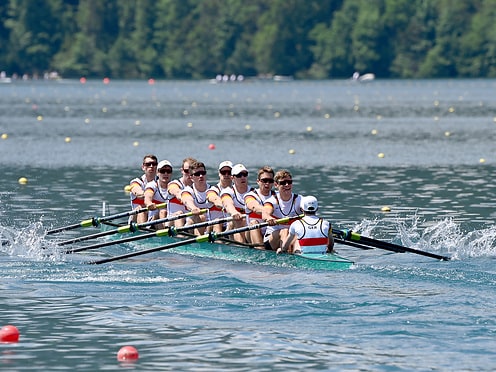The key to perfection: efficiency
The efficiency comparison between the Wilo-Stratos GIGA 2.0-I and the Team German Men’s Eight.
The Olympic victory of the German Men’s eight in London in 2012. A historic success for the team together with the main sponsor Wilo. What immediately caught the eye of many observers: a so-called rowing twin. Until then, this was a rare phenomenon that was realized by the team. A rowing twin means that two rowers’ row directly behind each other on the same side of the boat. But why are they using this concept?
It's all about efficiency and balancing the different power ratios of the individual athletes.
If you transfer this small but important detail to a pump from Wilo. You can quickly see parallels. Highly efficient pumps are the big issue. Less energy consumption thanks to better hydraulics.
But is this the only adjustment that can be made to the Deutschland-Achter boat and the Wilo-Stratos GIGA 2.0-I?
We spoke to Jörg Keller, Product Manager at Wilo SE, and the athletes Julius Christ and Sönke Kruse.

Mr. Keller, we now have the Wilo-Stratos GIGA 2.0-I in front of us. The world's first smart dry runner pump. And, highly efficient. Let's start right at the beginning. What did you looked for in the development of the pump alone?
When developing a pump, we pay particular attention to various aspects in order to maximize efficiency. These include optimizing the hydraulic design in order to achieve a high level of efficiency. This also includes the material. Above all, it should be of high quality in order to minimize friction losses.
If we now go one step further and look at the drive, the most energy-efficient motor in relation to the application must of course be selected.
At the very end, we then try to bring all aspects together and control them via an intelligent control system with the appropriate control functions.
Now you can see how much attention is paid to everything in the development area. But to get the best out of this, how exactly do you measure efficiency?
The efficiency of a pump is usually measured using the efficiency factor. The efficiency indicates the ratio between the power delivered (delivery rate) and the power consumed (drive power). The higher the efficiency, the more efficiently the pump works. The hydraulic efficiency is specified with a so-called "MEI-value".
Electric motors have different efficiency classes. The highest of these is the so-called "IE5".
If we now also look at the operation of the pump, it is particularly important to select a type from the portfolio of available pumps whose best efficiency point is close to the operating point that is to be used in the system.
So now you know how to measure efficiency and where it should go, but how do you get feedback, especially during operation? Can a "smart" pump do this independently?
Exactly right. The pump can transmit operating values such as power consumption, volume flow or delivery pressure electronically. The feedback from the pump itself can be recognized in the display or in the connected device, such as a smartphone. This means, for example, in which map range the pump is running. This can be used to determine whether the pump is the right one for the system or whether it can be adjusted even better.
If you look at the pump market now, you often see different shapes, sizes, and areas of application. Are some pumps more and some pumps less suitable as a high-efficiency product?
High-efficiency pumps always help to save energy thanks to their more efficient motors. This means that many pumps can be built to be highly efficient.
If we look purely at energy savings, we can already see a difference. In systems with variable flow rates and pressures, variable speed pumps can achieve the highest energy savings.
Thank you very much, Jörg Keller.

The Wilo-Stratos GIGA 2.0-I is familiar with the topic of efficiency right from the start. But what does it look like in a rowing boat? As a partner of Team Deutschland-Achter, we were able to speak to the two pairs athletes Julius Christ and Sönke Kruse.
Mr. Christ, Mr. Kruse, you have just heard about the areas of a pump in terms of efficiency, if we transfer the whole thing to a boat. What exactly does efficiency mean in rowing?
If we first look at the boats, we must differentiate between an eight-person boat and a two-person boat. In a big boat, it can be forgiven if one rower is not 100% efficient, as four athletes are rowing on the same side. If someone is not rowing well in a pair, we would be going round in circles.
If we look specifically at efficiency, it is primarily the execution of the movements. Every athlete has a certain physiological potential. And that's exactly what we try to achieve and utilize in the best possible way. You could say that we try to convert this potential into boat speed in the best possible way.
You said that it is primarily movement execution. But how can you measure movement? Do you have cameras on your boat at every training session?
That could be rather difficult with the cameras, but of course we sometimes have a coach with us who also looks at it. You can actually measure efficiency in the boat using various factors. But the most important thing is your own feeling. After many years of rowing, you quickly realize whether something is going well or not. Accurate values that we use every training session are primarily our heart rate values. Performance tests tell us what heart rate we can use to achieve what speed range. But here we are back to the body itself.
Looking at the boat, we have special measuring boats that have been developed to measure stroke distances. In addition, we can also use special sensorik paddles and find power losses in the movement. So, if someone puts the paddles on incorrectly, we can use the sensors to see in which part of the movement this occurs. But as already mentioned at the beginning, feeling takes precedence over all measured values.
Let's take a closer look at the movement itself. Is there also an optimum there?
Yes, absolutely. The rowing association has a model of what the optimal movement should look like. But let's be honest: every person is individual and therefore every movement is individual. The best example of this is running. Different running styles can also be efficient for each individual. However, we try to get as close as possible to the model in every training session. We also have special sessions on the rowing ergometer with a mirror to check this perfectly.
Now we've talked primarily about you and the movement. But now you can also imagine that a boat made of stones would go slower than a boat made of carbon. Have there been any major developments in terms of efficiency in recent years?
That's certainly true. Our boats are usually made from a kind of sandwich between carbon and Kevlar. The exact composition varies depending on the team and the requirements. It also depends a little bit on the water where the main competition takes place. This is because soft, warm water behaves differently to cold, hard water.
The big changes have mainly been in the area of the paddles. A few years ago, everyone was still rowing with hard wooden handles. Nowadays they are often rubberized. The paddles are also getting thinner and thinner. The main reason for this is to reduce drag. We always talk about the behavior of it in the water, but the return is also a major aspect. The greater the air resistance and the heavier the tools are, the more strenuous it is for us to guide the paddles backwards.
Looking at your answers, can we say that there are an incredible number of small adjustments that can be optimized?
Definitely. There are always little new aspects that we look at and try to implement from training session to training session.
Thank you, very much and good luck, at the next races.
















